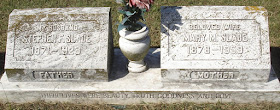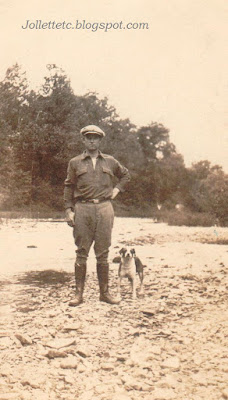The theme for this week’s
52 Ancestors challenge is
appropriate:
Independence. After all, the 4
th of July is one of the
favorite patriotic holidays in the United States. Parades, fireworks, and family
cookouts are happening in every community. Patriotic organizations like
Daughters of the American Revolution (DAR) honor their ancestors with
wreath-laying ceremonies at national monuments and placing flags at graves of
patriots.
I am proud to claim a number of patriots who helped
America achieve independence. For over a year I had been trying unsuccessfully
to join DAR through Leonard Davis of Rockingham County, Virginia when I received
an email from a gentleman who was transcribing records for Albemarle County. As
part of his project, he searched online for additional information relating to
the documents he was working on. That is how he found my blog. He saw names on
my blog that were also included in a chancery suit he was then transcribing. He
offered me a copy. As I read it, I immediately saw my express ticket into DAR
through my 4x great-grandfather William Jordan.
 |
| Service Record of William Jordan, a soldier from Virginia |
Thanks to Fold3, I have a copy of William Jordan’s
pension application containing many details about his early life and service to
his country. Apparently his first attempt to secure a pension was denied for
failure to provide actual PROOF of service. His discharge papers had been lost
years before in a house fire. Subsequent hurdles to obtain a pension included
several court appearances like this one:
 |
| Questions posed to William Jordan in court |
Sworn to and Subscribed in open Court and thereupon the Court
propounded to the applicant the following Interrogations.
1. Where and in what year were you born
A. I was born on the Schuylkel [sic.] river about six
miles from Philadelphia the 20 Jany 1760
2. Have you any record of your age, and if so where is it?
A. I have none.
3. Where were you living when called into service? Where have
you lived since the revolutionary war and where do you now live?
A. When called into service I lived in Augusta County
Virginia. About the year 1783 or 4 I removed from the County of Augusta to
Albemarle County and lived some years in the adjoining county Orange, but now
live in Albemarle County Virginia.
4. How were you called into Service were you drafted did
you volunteer or were you a substitute and if a substitute, for whom?
A. I was drafted as a militiaman
5. State the names of some of the regular officers who
were with the troops where you served with Continental and Militia Regiments as
you can recollect and the general circumstances of your service
A. In the first tour I was drafted and served under Capt.
Wm Kincaid. In the second under Capt Patrick Buchanan Major ___ Brooks Col
Howard & General Morgan. In the third under Cap Givens Major Boyce Col
Cameron & Gen Campbell in the fourth under Capt Wm Findlay Major Wilson (he
believes) & Col Vance
And the said Court do hereby declare their opinion after
the investigation of the matter and after putting the interrogation prescribed
by the war department that the above named applicant was a revolutionary soldier
and served as he states
State of Virginia
I Ira Garrett clerk of the Court of Albemarle County do
hereby certify that the foregoing contains the original proceedings of the said
court in the matter of the application of William Jordan for a pension.
In Testimony whereof I have hereunto set my hand and seal
of office this 15th day of November 1832 in the 57th year
of the Commonwealth
Ira Garrett CAC
In May of the following year William Jordan tried again
by offering further information. A. Broadhead, a Justice of the Peace for
Albemarle County, submitted an affidavit in which he explained that “William
Jordan . . . by reason of old age and
the consequent loss of memory . . . cannot swear positively as to the precise
length of his service. . . .” However, William Jordan was positive he served as
a private from May to October in 1779. He took part in an expedition against
the Indians on the West Fork of the Monongahela River as a private in Capt William
Kincaid’s company. Then from October 1780 until May 1781 he served again as a
private.
 |
| Affidavit of William Brooks |
An affidavit provided by William Brooks revealed more
about their service together as militiamen. They marched from Albemarle under
the command of Capt Patrick Buchanan and joined General Daniel Morgan at Six
Mile Creek in North Carolina. They then were commanded by Col Howard from
Maryland and General Morgan at the Battle of Cowpens (South Carolina), 17
January 1781. Using a little battlefield trickery, the American troops fooled
the British into thinking they were retreating causing the British to run
straight into concentrated rifle fire and cavalry charge. Due to heavy
casualties inflicted on the British by American troops, the Battle of Cowpens
is regarded as a major battle and a turning point in the war.
 |
Painting by Don Troiani depicting the Battle of Cowpens
British Light Dragoons against General Morgan's cavalry
image from Wikimedia Commons |
On a side note, the Battle of Cowpens was the inspiration
for the final battle at the end of the film The Patriot starring Mel Gibson. Sweet
Liberty, an earlier movie starring Alan Alda, parodies how film companies often
take liberties with the depiction of the Battle of Cowpens.
Another affidavit provided by John Diddle said that William
Jordan was at the Battle of Jamestown, the last major land battle in Virginia
prior to the Siege of Yorktown. The American forces were ambushed near Green
Spring plantation 6 July 1781 but did not fare very well in a battle that is
thought to be one of the bloodiest and most intense of the war.
Jordan was less certain about his final tour but
remembered serving in Capt William Findlay’s company and Col Vance’s regiment before
becoming ill following the march to the Siege of Yorktown, the battle that
marked the end for England in the American colonies. It also marked the end of
William Jordan’s service as he was furloughed and never able to return to
service.
 |
| Pension card |
William Jordan eventually received a pension of $33.77 per
annum. According to one inflation calculator, that amount had the same buying
power as $870 today.
In the beginning, the thirteen colonies did not have in
mind becoming one big country. Rather they sought independence from England to
become thirteen little countries, each with its own government and its own
money. The leaders who framed the Declaration of Independence and later the Constitution
looked into the future and saw that no new little “country” would be a match
against possible future invasions by Spain, France, or England. Uniting would
be the best course.
 |
| images from Wikimedia Commons |
And my William Jordan at age 19 aided the cause marching
to and fighting in three colonies; he was right there in the company of our
heroes, men like Marquis de Lafayette, “Mad” Anthony Wayne, Nathanael Green,
and “Old Wagoner” Daniel Morgan.
I wonder what he thought about that.
Wendy
© 2018, Wendy Mathias. All rights reserved.















































